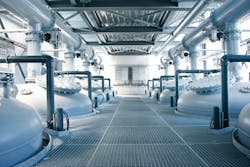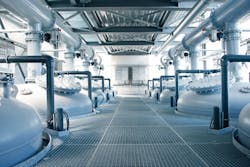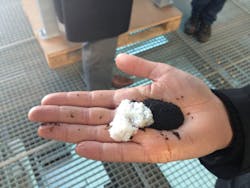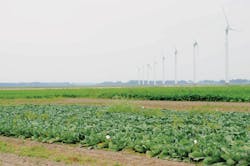The New Black Gold?
Ion Exchange in the Decolourisation of Drinking Water
During a pilot study to decolour drinking water, it was discovered that the perceived waste stream removed actually contained humic acids and table salt. In 2013 a plant was built in Spannenburg, the Netherlands which will process this waste stream, using zero liquid discharge (ZLD) to produce a valuable fertilizer.
By Alexander Laarman & Peter Sjoerdsma
The groundwater from the production sites Oldeholtpade, Spannenburg and Sint Jansklooster in the Netherlands is characterised by relatively high colour and total organic carbon (TOC) concentrations, due to peat layers in the underground. This colour is caused by organic matter that is also known as humic acid.
After extensive pilot studies at the locations Oldeholtpade and Spannenburg, with respectively anaerobic membrane filtration and ion exchange, the first decolourization installation based on ion exchange has been operational since 2006.
Important features of the installations are the relatively high loading of the ion exchange resin, the three-fold re-use of the regenerant and the limit of the residual stream by the use of nano-filtration.
The residual has a total volume of 4100 m3/year. Considering the annual drinking water production capacity of all three locations of 35 milllion m3 this is a relatively small volume. However, because of the high sodium chloride content of 3-4% and organic matter concentration of 5-8% of the material, it is not allowed to discharge this waste stream into the municipal sewage and therefore it is necessary to find an alternative solution. At the time only the colour removal plant of Oldeholtpade was operational, the material was transported to the wastewater treatment plant in Harlingen.
However, in 2011 when the material of the decolour installation of Spannenburg was added, the high volume negatively influenced the quality of the WWTP effluent. This forced Vitens to discharge the material to AVR Rozenburg where it was incinerated. The costs for the disposal of this waste stream are around half a million euro per year.
Humic acids: the market
Shortly after commissioning the first decolour installation in 2006, Vitens searched for a method to reduce the residual as much as possible and strive for a Zero Liquid Discharge (ZLD) operations. The focus of this research was to decompose humic acids (the problem) whereby the salt (valuble component) can be reused for the regeneration process. Several methods have been investigated, but all were difficult to achieve in practice.
The solution was to turn around the focus: the problem is an opportunity. Internally a dedicated team was established to explore the possibilities from a market point of view. An extensive market scan showed that humic acids are valuable substances, with different market applications in agriculture and horticulture, plant breeding and even as a supplement for animal nutrition.
In order to realize this opportunity two aspects of the residual had to change to respect the demand of the market: 1) the salinity and 2) the humic acid concentration. In the search for a ZLD operation of the decolouring process research was focused whereby salt is separated from humic acids. As a result, this not only realized the possibility to re-use salt as a regeneration agent, but also for the valorisation of humic acids as a valuable raw material.
Diafiltration research
The diafiltration method, which is often applied in the dairy and (bio) pharmaceutical industry, is a technique based on a separation process using membrane filtration. To determine the suitability of diafiltration as a separation technique for desalting the residual, a pilot study was conducted. A batch of 200 litres DENF - concentrate derived from production plant Spannenburg was used. The choice of the membrane is crucial for diafiltration. In the past, research has shown that the Trisep XN45 membrane ensures an almost complete retention of organic matter and at the same time is completely permeable to sodium ions and chloride. These nano filtration membranes are already used in the DENF installations on Spannenburg and Sint Jansklooster and are used for the pilot study.
The pilot has established that the DENF - concentrate with a salt concentration of 40 g NaCl/l is desalinated to a concentration less than 1 g NaCl/l. The volume of wash water required to achieve this concentration was less than three times the starting volume. During diafiltration the concentration of NaCl in the filtrate is more and more reduced. When the salt concentration reached a minimum level, the process is stopped.
Using diafiltration, you would end up with desalted organic material, but the volume would still be equal to the starting situation. Therefore, the pilot study was continued by focussing on the diafiltration product.
To concentrate this an increasingly higher pressure was required in order to maintain the flux, because the amount of dry matter in the treated liquid increases during the concentration process. During both diafiltration and concentration step, the pressure gradually increased to the maximum allowable pressure of 45 bar. As a side effect temperature increased up to 40oC. The consequence is that the content of organic material into the filtrate increases due to the higher permeability of the membrane. This results in an undesirable loss of 21% humic material and a strong loss of energy.
Re-use of salt and water by RO
To meet market requirements, the salt concentration of organic material had to be reduced by a factor of 40. This needed washing water, which is about three times the input volume. To meet the objective of ZLD operations as much as possible this washing water from diafiltration and concentration process is also treated. The processing of this washing water can be performed with reverse osmosis (RO). With this process the salt content can be concentrated to a concentration that can be used in the regeneration process of the decolouring installation. In addition, water extracted by the RO can be used as wash water in the diafiltration process.
Based on this pilot study, an installation has been realized at Spannenburg that will process the total residual of the three production sites Spannenburg, Oldeholtpade and St. Jansklooster with a total volume of 4,100 m3. This installation built in a separate building is operational since July 2013 and will include storage tanks for the various media. Compared to the pilot study the situation in practice will be carried out with a number of adjustments in order to increase the efficiency, which reduced the loss of pressure energy, and organic material.
Based on the pilot, the installation at Spannenburg will process the total residual of 4,100 m3 into 810 m3 per year. This residual comprises of less than 0.25% salt and 20% humic acid. With these humic acids, a first field trial is completed to determine the effectivity on crop growth. The results have shown that these humic acids are very effective and showed a 7% yield of cabbage compared to standard fertilization.
Therefore, volume, composition and effectiveness of these humic acids meet the requirements for the application of humic acids as a soil conditioner for the entire Dutch market. In this context Vitens now is not only a large producer of the precious resource water, but also large producer of valuable resource humic acids.
Conclusion
By means of a market-driven demand for raw materials, it is possible to find innovative solutions for a residual stream to be converted into valuable products: water, salt, and humic acid.
With diafiltration and nano filtration, the residual flow of the regeneration process of the ion exchange resins, is largely desalted and the volume is substantially reduced. Through RO the salt can be reused as a regeneration agent and the water can be reused as washing water for diafiltration. This results in a residual flow of only humic acids. This material is named HumVi: a product for Dutch agriculture and horticulture to improve soils and to increase crop yields and is currently available in the market as HUMIC supplied by Triferto.
Soil fertilizer is one of the most common use of humic acids. These are known for their valuable characteristics, such as improving the soil structure, allowing the retention of water and nutrients whereby better absorbed by crops. Furthermore, the humic acids that are sold in the Netherlands are mainly from the United States. These humic acids are extracted from lignite through a chemical process.
This case study in the Netherlands demonstrates how instead humic acids can be extracted from groundwater and can now be used in the agricultural sector as a 100% sustainable and high quality soil fertilizer. Over ground, the application of humic acids directly benefits the farmer by increasing crop yields and reduced use of pesticides and fertilizers. Underground this improves soil quality by the reduced leaching of fertilizers and pesticides and by promoting local biodiversity. As important side effect this assures in the long term the quality of groundwater.
This article was co-authored by
Alexander Laarman, research business development and Peter Sjoerdsma, process engineer at Vitens.
Email:[email protected]



